President Brad D. Smith’s listening tour laid the groundwork for the future direction of the university.
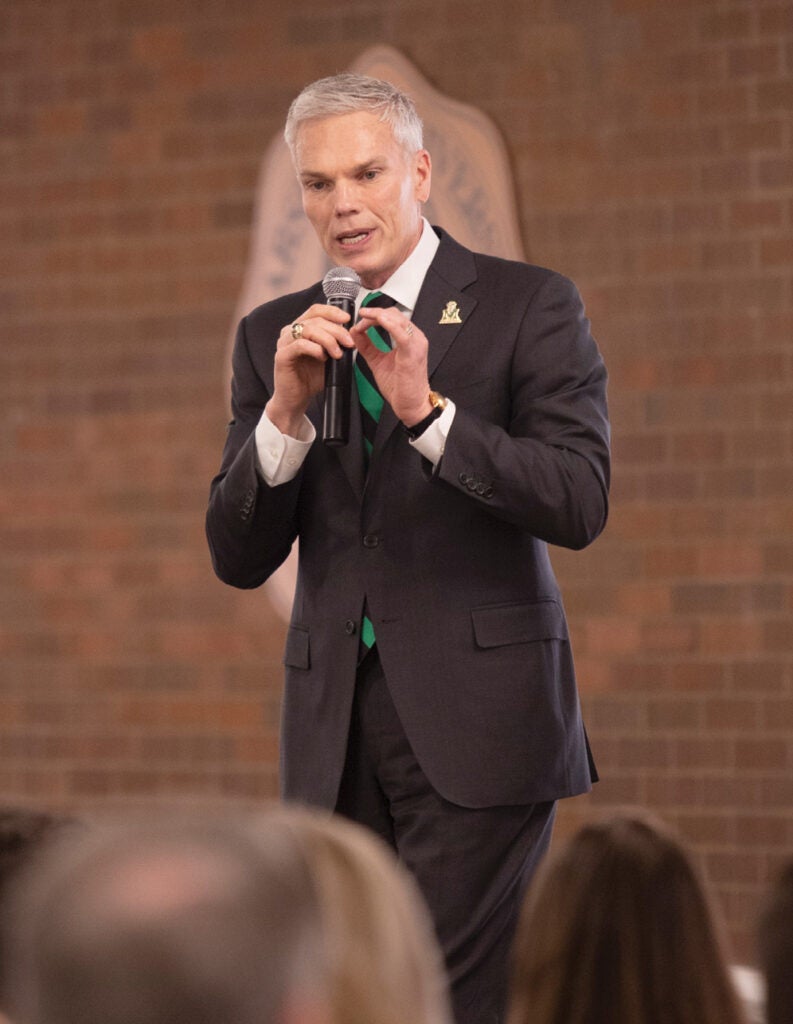 Growing up, Marshall University President Brad D. Smith was often reminded, “You were born with two ears and one mouth. Use them in that proportion.”
Growing up, Marshall University President Brad D. Smith was often reminded, “You were born with two ears and one mouth. Use them in that proportion.”
“It was one of my mom’s favorite sayings,” Smith said.
Smith carried those words with him as one of Silicon Valley’s preeminent CEOs, and they remained at the top of his mind as he stepped into the role of Marshall president.
“Over the years, I’ve come to appreciate that you should first seek to understand before seeking to be understood,” he said.
It’s fitting, then, that Smith’s first presidential undertaking was, simply, to listen.
“I thought it would be best to begin by listening,” Smith said. “I recognize that even though I was born in this area and I’m a Son of Marshall, I’ve been gone for 36 years. I didn’t want to assume that I knew the things that were most important to focus on.”
To gain insight into what matters most to the Marshall community, Smith kicked off his presidency with a 100-day listening tour, meeting with students, alumni, faculty, staff, community leaders and others in 38 separate listening sessions. More than 1,000 people participated in the sessions, garnering more than 1,200 suggestions for the university.
Board of Governors Chairman Patrick Farrell said Smith’s tour, which also included visits to other campuses and conversations with 18 college and university presidents, was inspiring to witness.
“President Smith has an extraordinary ability to listen and empathize with people so they really feel understood,” Farrell said.
An outside firm analyzed the data from the listening tour. The suggestions were organized by theme, and the most frequently referenced themes were identified as key areas. Smith labeled these areas “The Big Five.”
“It was surprising to see how aligned our campus community is about what our priorities should be,” Farrell said. “It’s normally hard to get large groups to agree on almost anything, but it’s clear from the listening tour feedback that there’s widespread agreement among our stakeholders about where we should focus our resources.”
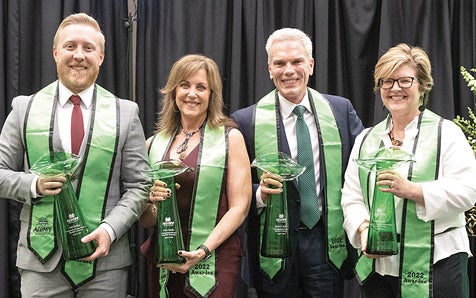 The Big Five are: 1) increasing enrollment, using an “end-to-end” approach that begins when a student first learns about Marshall and ends with lifelong alumni engagement; 2) improving the student experience, with targeted efforts for commuters, online learners and other nontraditional students; 3) investing in staff and faculty with an emphasis on compensation, resources and professional development; 4) increasing efforts in diversity, equity and inclusion; and 5) advancing the university’s marketing strategy to better tell the Marshall story. Efforts are already underway in each area.
The Big Five are: 1) increasing enrollment, using an “end-to-end” approach that begins when a student first learns about Marshall and ends with lifelong alumni engagement; 2) improving the student experience, with targeted efforts for commuters, online learners and other nontraditional students; 3) investing in staff and faculty with an emphasis on compensation, resources and professional development; 4) increasing efforts in diversity, equity and inclusion; and 5) advancing the university’s marketing strategy to better tell the Marshall story. Efforts are already underway in each area.
Smith said that seeing the level at which certain topics resonated among the different groups was eye-opening. For example, increasing enrollment by making Marshall more affordable, particularly for metro residents, was a leading issue brought up in multiple sessions.
“That was top of mind for many people,” Smith said. “And what I love is that we’re already taking action. We’ve made pricing decisions to hold our tuition relatively flat even in an inflationary market, and we just expanded our metro discounts to a total of 59 counties in Ohio and Kentucky. That’s a 100-mile radius that can get tuition rates lower than the in-state rates in Ohio and Kentucky.”
The administration has also hit the ground running in bolstering Marshall’s marketing strategy, with digital marketing campaigns and storytelling efforts that align with the university’s mission and vision.
“One thing that really bubbled to the top during the listening tour was that we need to be aligned as a university community on what our vision is — who we are, who we aspire to be — and then build a concrete strategy as we move forward,” Smith said. “For a long time there were questions of, ‘Do we want to be a high-research university?’ ‘Do we want to be another WVU?’ What we want to be is a great Marshall University. The question now is, ‘What does that look like?’”
The university has partnered with McKinsey Consulting to help build that narrative and increase awareness of Marshall throughout the nation and world. Smith can hardly contain his excitement for what they’ve come up with.
“As we wrap up the work with McKinsey, I’ll just put a teaser out there: ‘Marshall for all. Marshall forever,’” Smith said with a smile. “And we’ll explain more soon.”
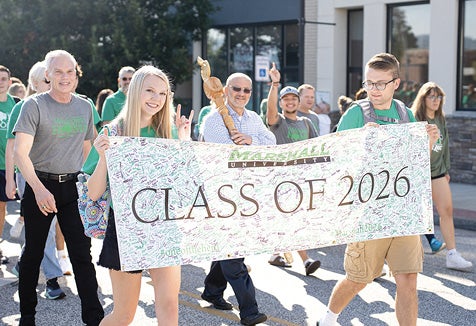 Decisive action is taking place in the other areas as well. A comprehensive compensation analysis is being conducted to identify potential inequities due to gender, race or other factors. Through a partnership with consulting firm InfoTech, the university is working to modernize its IT platforms and processes. Marshall is adopting a Responsibility Center Management (RCM) philosophy, an approach that gives academic administrators more control over resource decisions. The university’s Strategic Enrollment Management plan will work to increase enrollment, expand recruitment initiatives and improve retention rates. And key leadership positions in diversity, equity and inclusion have been filled in order to better facilitate the university’s diversity and equity work.
Decisive action is taking place in the other areas as well. A comprehensive compensation analysis is being conducted to identify potential inequities due to gender, race or other factors. Through a partnership with consulting firm InfoTech, the university is working to modernize its IT platforms and processes. Marshall is adopting a Responsibility Center Management (RCM) philosophy, an approach that gives academic administrators more control over resource decisions. The university’s Strategic Enrollment Management plan will work to increase enrollment, expand recruitment initiatives and improve retention rates. And key leadership positions in diversity, equity and inclusion have been filled in order to better facilitate the university’s diversity and equity work.
Complementing all these efforts is a shared governance ad hoc committee focused on promoting transparency, accountability, inclusivity and collaboration. Smith said the concept of shared governance is vital to Marshall’s future success.
“All strong cultures and great decisions are made better by diversity: diversity of thought, diversity of experience and demographic diversity like gender, race and sexual orientation,” Smith explained. “And that’s really the foundation of shared governance. Shared governance means that all the powers that be — students, faculty, staff, the Board of Governors, the administration — are coming together and collectively working on the major decisions that affect the university. To be clear, there are primary decision-makers in certain areas — the faculty is the primary decision-maker on the academic side of things, and there are areas where the administration is the primary decision-maker. But all the groups have a voice.”
The ad hoc committee is conducting a study of other universities that utilize shared governance in order to put their best practices in place at Marshall.
“They are studying the best practices of universities that not only have strong shared governance but also move at the speed of life, because one thing we all recognize is that we can’t measure the world by semesters when things are changing by day,” Smith said.
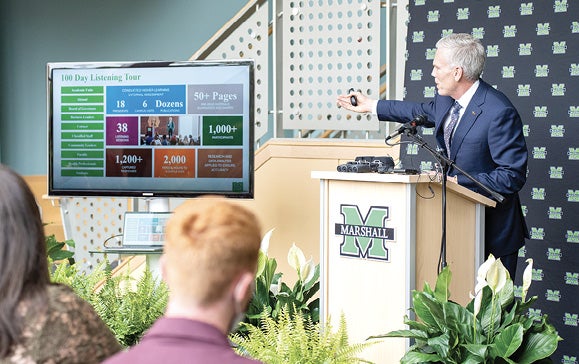
Tackling the Big Five and moving Marshall forward takes everyone, Smith said. And it was in that spirit of collaboration that Marshall held its inaugural Community Cares Week, a series of service projects that gave the Marshall family an opportunity to give back to the institution through sweat equity last June.
“We thought we’d have 50 people show up,” Smith said. “Then we said, ‘Let’s dream big. Maybe we’ll have 250.’ Well, we had 451 people show up. And I have not walked out of my office a day since and not seen someone I worked with that week.”
Smith, whose jobs included power washing, painting, planting trees and scrubbing the floors of Corbly Hall, said one moment in particular stood out to him. He was assigned to a shift with a group of incoming B.S./M.D. students, high school seniors preparing to earn both their Bachelor of Science and Doctor of Medicine at Marshall in an accelerated program. Their task that day was to put together park benches, securing new wood to stone frames throughout campus.
“I was working with two young women, and when we were finished one of them asked if I’d take a picture of them on one of the benches,” Smith recalled. “I did, and I handed her phone back to her. As I was walking away, I overheard her say, ‘I want to have this picture so that one day when my daughter comes to Marshall, she’ll see the bench that her mother built.’”
He said tears ran down his cheeks as he walked back to his office.
“This was a 17-year-old girl, who had just finished doing very hard work, with people she’d never met before, on a campus she wasn’t officially a part of yet — but she’s already envisioned herself having a daughter who will follow in her footsteps at Marshall and sit on the bench her mother built,” Smith said.
That’s the power of “we,” he asserted.
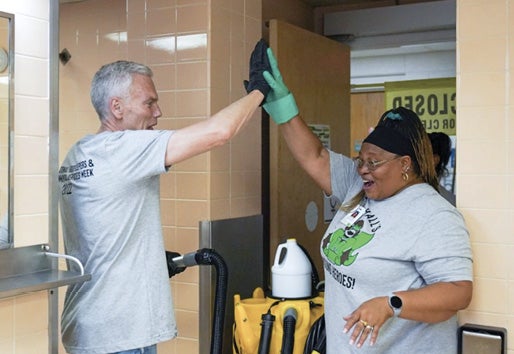
“I’ve always felt that the most important word in ‘We are … Marshall’ is the word ‘we,’” he said. “This is the community’s university. This is Appalachia’s university. And quite frankly, it’s the world’s university. Everywhere I’ve traveled, if I say, ‘We are …’ someone will call out, ‘Marshall!’ They’ve seen the movie. They know our story. We have a part to play in a bigger picture.”
In a sense, bringing that bigger picture to life was the goal of the listening tour. While the tour has ended and 100 days in office have turned into 200, and soon 300, that doesn’t mean things are slowing down for Smith. He’s just getting started.
“People sometimes ask me if being the president of a university is very different from being the CEO of a Fortune 500 company,” he said. “My answer is that the hours really aren’t that different. What’s different is that not a day that I’ve been here has felt like work. It feels like purpose.”
———–
About the author: Katherine Pyles is a freelance writer living in Huntington, West Virginia. She is a 2009 graduate of the Marshall University School of Journalism and Mass Communications.
Photos (from top):
Brad D. Smith began his presidency with a Listening Tour. The 1,200+ responses he received were referenced when adressing the “Big Five” key areas of concern for the university’s future.
The 2022 Alumni Award recipients Jeff McKay (Distinguished Young Alumnus), Alys Smith (Distinguished Service to Marshall University), Brad Smith (Distinguished Alumnus) and Cathy Burns (Outstanding Community Achievement) were honored April 9.
Marshall’s annual Week of Welcome (WOW) included a full schedule of activities in August to welcome the Class of 2026. Shown is the Freshman Walk held on Fourth Avenue between campus and the Keith-Albee Performing Arts Center in Huntington.
President Brad D. Smith’s first press conference recapped his first 100 days in office including a summary of the issues brought to his attention during his extensive listening tour.
Brad D. Smith assisted with housekeeping in residence halls during International Housekeepers and Environmental Services Week which honors the “unsung heroes” of the housekeeping, grounds crew and sustainability staff.